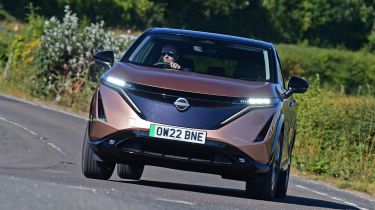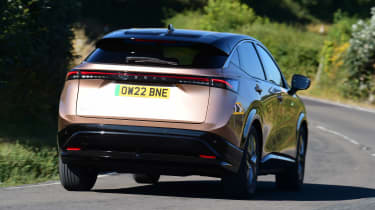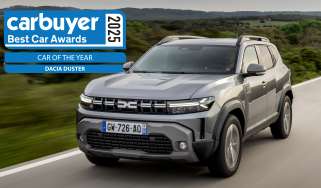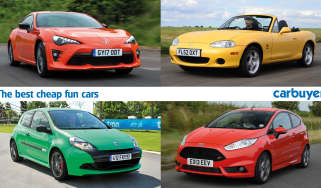Nissan Ariya SUV - Electric motors, drive & performance
The Ariya handles well and offers decent performance, but is much better suited to relaxed city driving
Nissan has created some of the most compelling sports cars over the last few decades such as the supercar-bashing Nissan GT-R and the driver-focused Nissan 370Z. So with that in mind, how does the Ariya scrub up?
The Ariya is enjoyable to drive, with the low centre of gravity of its battery helping it to feel more agile than its closest competitors. While there is not much of what we would call ‘steering feel’ (the sensation of feeling exactly what the car is doing through your hands), the Ariya handles confidently and maintains its composure through bends. For more enthusiastic drivers, there is a rather tempting ‘Sport’ mode which sharpens the car’s steering and acceleration – although driving in an exuberant manner will quickly take its toll on the level of charge.
The Nissan Ariya is available with four electric-motor setups. The entry-level system consists of a single, front-mounted electric motor with 215bhp. Although this figure may seem relatively small for a car that weighs over two tonnes, the end product is something that feels relatively brisk under acceleration and should be sufficient for most Ariya owners.
Working your way up through the range will add more power, while some of the top trims are also available with e-4ORCE all-wheel drive. These versions pack more than 300bhp, with the range-topping Evolve+ getting an Audi RS-rivalling 388bhp. This version is very quick indeed.
All powertrains feature what Nissan calls e-Pedal Step. First making its debut on the smaller Nissan Leaf before making its way to the Ariya, this is the brand’s version of one-pedal driving, which slows the car down using the electric motors to recharge the battery. Unlike other EVs, however, e-Pedal will not bring the car completely to a halt, making the Ariya drive feel closer to a traditional petrol or diesel car than its electric rivals.
0-62mph and top speed
From a standstill, 0-62mph in the single-motor Ariya takes around 7.5 seconds; however, the instant torque from the electric motor means that this feels much faster. Because of this, getting up to 30mph should be slightly quicker than in an equivalent petrol-powered car; dashing between the traffic lights on busy city streets is a breeze.
The more powerful electric motor setups are only available with the larger 87kWh battery, with the front-wheel-drive option getting 239bhp. This extra power is largely offset by its extra weight (the 0-62mph time is a tenth-of-a-second slower), but it still feels smooth and punchy.
Then there’s the e-4ORCE range-topper, which depending on which trim you opt for, has as much as 388bhp – good for 0-62mph in 5.1 seconds. Standard e-4ORCE models still get 302bhp, however, and manage the same benchmark sprint in less than six seconds. Honestly though? In a car set up primarily for comfort, this kind of overtaking power seems unnecessary.
|
Model |
Power |
0-62mph |
Top speed |
|
63kWh Engage/Advance/Evolve |
215bhp |
7.5s |
100mph |
|
87kWh Engage/Advance/Evolve |
239bhp |
7.6s |
100mph |
|
e-4ORCE 87kWh Advance/Evolve |
302bhp |
5.7s |
100mph |
|
e-4ORCE 87kWh Evolve+ |
388bhp |
5.1s |
124mph |
Carbuyer notes
“Fundamentally, the Nissan Ariya feels like a car designed to be cosseting and comfortable, rather than fast and fun. For this reason, we’d stick with the less powerful models and enjoy the longer range…













